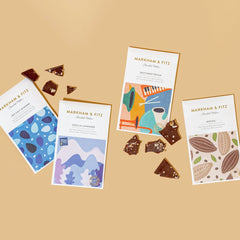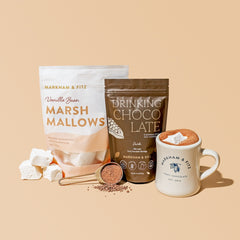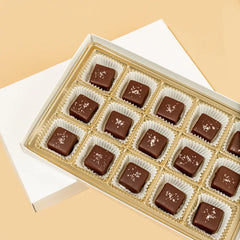Introduction: Chocolate’s Sweet Journey Through Time
Chocolate is more than just a sweet treat—it’s a cultural phenomenon that has been cherished for thousands of years. From ancient civilizations to modern artisans, chocolate has evolved from a sacred drink to the indulgent confections we enjoy today.
But who exactly invented chocolate, and how did it become the beloved delicacy it is now? In this blog, we’ll explore the rich history of chocolate, from its beginnings in the tropical rainforests of Central and South America to the artisanally crafted chocolates made by companies like Markham & Fitz.
So, grab a piece of your favorite chocolate (perhaps something from Markham & Fitz’s collection) and let’s dive into the story of how chocolate came to be.
1. The Ancient Origins of Chocolate: A Gift from the Gods
The story of chocolate begins over 4,000 years ago in the tropical rainforests of the Amazon and Orinoco River basins, where the cacao tree (Theobroma cacao) grows wild. The first known people to cultivate and use cacao were the ancient Olmecs, who lived in what is now southern Mexico.
For the Olmecs, cacao was more than just food—it was considered a divine gift. The word "Theobroma" means "food of the gods," and cacao played an important role in religious rituals and ceremonies. The Olmecs were likely the first to ferment, roast, and grind cacao beans to create a bitter drink that was consumed during special occasions.
The Maya civilization, which thrived in the region from about 2000 BCE to 1500 CE, adopted the Olmecs' love of cacao and expanded its use. The Maya made a drink called "xocolatl," which was made from ground cacao beans, water, and spices like chili and vanilla. Unlike the sweet chocolate we know today, this early version was bitter and frothy, but it was highly valued for its invigorating properties.
The Maya also used cacao beans as currency, trading them for goods and services. In their society, cacao was considered a symbol of wealth and was often given as gifts during important social events and religious ceremonies.
[Try Some Favorite Gifting Chocolates from Markham & Fitz]
2. The Aztecs and Cacao: A Drink of Power and Prestige
When the Aztec Empire rose to power in the 14th century, they too embraced cacao as a sacred and valuable commodity. The Aztecs believed that cacao was a gift from their god Quetzalcoatl, and they used it in both daily life and religious rituals.
For the Aztecs, cacao was consumed as a bitter, spiced drink, similar to the Mayan version but often mixed with chili peppers and cornmeal to create a thicker, more substantial beverage. Only the elite members of society, including rulers and warriors, had access to this luxurious drink.
Cacao beans were so valuable that they were used as currency in the Aztec economy. In fact, taxes were sometimes paid in cacao beans, and large amounts of beans were stored in royal treasuries. The Aztec emperor Montezuma II was said to drink several goblets of cacao each day to boost his energy.
It wasn’t until the Spanish arrived in the Americas in the early 1500s that cacao’s popularity would spread to Europe, leading to the invention of sweetened chocolate as we know it today.
Try Markham & Fitz Drinking Chocolate
3. The European Transformation: Sweetened Chocolate is Born
When Spanish explorer Hernán Cortés encountered the Aztecs in 1519, he was introduced to their cacao drink. Cortés and his men initially found the bitter concoction unappealing, but they quickly realized its value. Cortés brought cacao beans back to Spain in the early 16th century, where the drink was sweetened with sugar and sometimes flavored with cinnamon or vanilla.
The sweetened version of chocolate quickly became popular among the Spanish elite. By the 1600s, chocolate had spread throughout Europe, becoming a fashionable drink among royalty and the upper class. In France, for example, King Louis XIV made hot chocolate a staple of courtly life, while in England, "chocolate houses" became popular gathering spots for the wealthy.
For centuries, chocolate was consumed only as a drink and was considered a luxury item due to the high cost of imported cacao and sugar. It wasn’t until the 19th century, with the advent of the Industrial Revolution, that chocolate became more accessible to the masses.
4. The Birth of Solid Chocolate: From Drink to Bar
The transition from drinking chocolate to eating chocolate began in the 1800s. In 1828, Dutch chemist Coenraad Johannes van Houten invented the cocoa press, a device that could separate cocoa butter from cocoa solids. This invention made it possible to create a powder from cacao beans, which could then be used to make solid chocolate.
By 1847, the first solid chocolate bar was created by British chocolatier J.S. Fry & Sons. Shortly after, Swiss chocolatier Daniel Peter combined milk powder with chocolate, creating the first milk chocolate bar in 1875. These innovations paved the way for modern chocolate as we know it, including the bars, truffles, and other confections that we enjoy today.
Markham & Fitz’s chocolates are crafted with the same dedication to quality and innovation that early chocolatiers brought to the craft. Our commitment to ethically sourced cacao and artisanal techniques ensures that every bite of our chocolate is a celebration of this rich history.
Try Markham & Fitz Chocolate Bars
5. Modern Chocolate: From Mass Production to Artisan Craftsmanship
In the 20th century, chocolate became more widely available, thanks in large part to advances in mass production techniques. Brands like Hershey and Cadbury made chocolate an affordable treat for the general public, and by the mid-1900s, chocolate had become a global phenomenon.
However, in recent years, there has been a resurgence of interest in high-quality, small-batch chocolate, as consumers seek out more artisanal and ethically produced products. This has led to the rise of the "bean-to-bar" movement, in which chocolatiers like Markham & Fitz take control of every step of the chocolate-making process, from sourcing the beans to crafting the final product.
At Markham & Fitz, we believe that chocolate should be made with care and respect for both the environment and the people who produce it. Our bean-to-bar process allows us to highlight the unique flavors of the cacao beans we use, resulting in chocolates that are not only delicious but also a testament to the rich history and craftsmanship of chocolate-making.
Our bean-to-bar process includes the process of stone grinding cacao beans, which preserves flavor and quality of the cacao, whereas mass-production techniques utilizes the cocoa press (separating powder and butter) and also lower quality beans. Often, to mask flavor deficits, mass produced chocolate contains vanilla to cover up off flavors in the cacao. On the contrary, we want the natural cacao flavor to shine through, which is why we meticulously roast, grind and hand process our chocolate to achieve the highest quality results.
Trust us, you'll taste the difference!
Markham & Fitz Bean-to-Bar Products
6. Chocolate Today: A Global Obsession
Today, chocolate is enjoyed in countless forms around the world, from simple bars and truffles to elaborate desserts and gourmet pairings. While chocolate’s journey has evolved over thousands of years, its appeal remains timeless. Whether it’s a small indulgence during a busy day or a gift for a special occasion, chocolate continues to bring joy to people’s lives.
At Markham & Fitz, we’re proud to be a part of this enduring tradition. Our chocolates are crafted with the same passion and dedication that has defined the history of chocolate for centuries. By combining ethical sourcing with artisanal techniques, we create chocolates that honor the past while looking toward the future.
Check out Markham & Fitz products here.
Conclusion: Celebrating Chocolate’s Past and Future
Chocolate’s journey from ancient civilizations to modern-day indulgence is a testament to its lasting appeal. Whether you’re savoring a piece of rich dark chocolate or enjoying a creamy milk chocolate truffle, you’re part of a tradition that spans thousands of years.
At Markham & Fitz, we’re dedicated to continuing this tradition by crafting chocolates that celebrate the history and artistry of cacao. So next time you enjoy one of our creations, take a moment to appreciate the rich history behind every bite—and know that you’re tasting a piece of chocolate’s remarkable journey.




Leave a comment